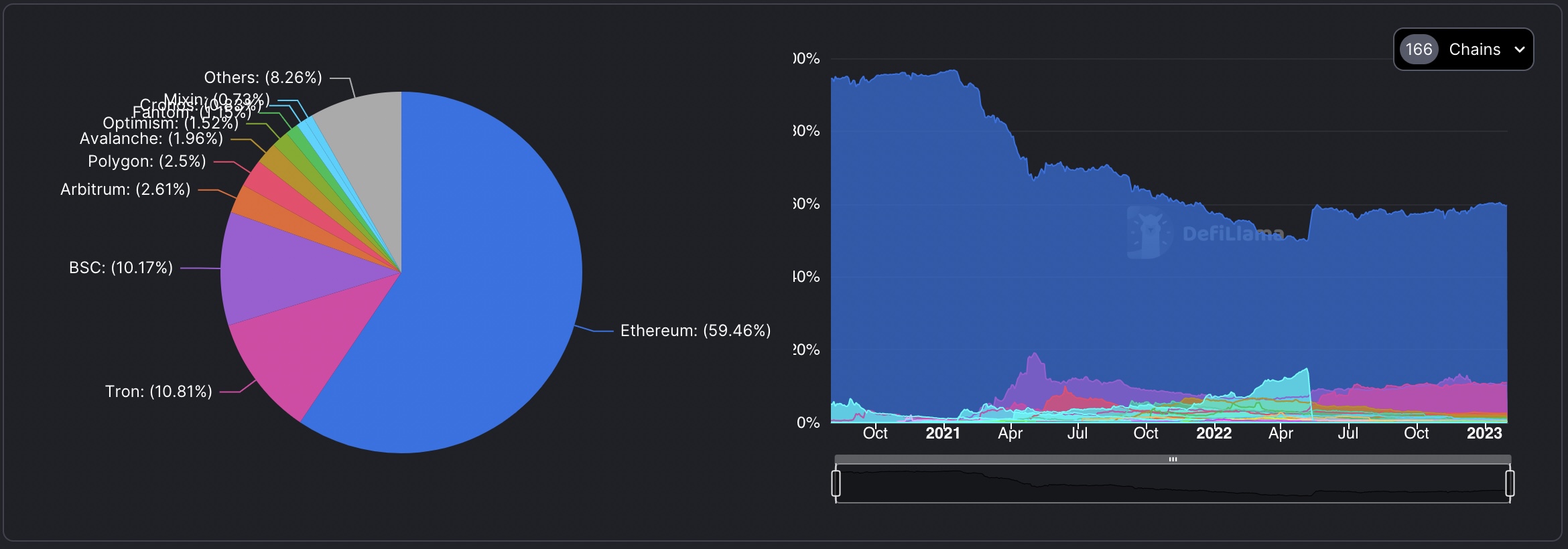Ethereum’s Shanghai fork is coming — but it doesn’t mean investors should dump ETH

Ethereum’s next big upgrade, Shanghai, is on the horizon for March. The Shanghai hard fork will implement further improvement proposals for the Ethereum network as well as enable Ether (ETH) stakers and validators to withdraw their assets from the Beacon Chain.
At the time of writing, staked ETH represents approximately 14% of the total supply, or 16 million coins. It equates to over $25 billion at ETH’s current price, a substantial sum that will gradually become liquid following the fork.
Some ETH stakers have waited over three years to withdraw their rewards. Does that mean most of them will line up to withdraw and sell their ETH as quickly as possible? This scenario is improbable. There are numerous reasons why investors shouldn’t be concerned about the impending update, and even more why most Ethereum stakeholders will increase their investment into staking following Shanghai.
Ethereum will remain the leading PoS network
Although ETH is the second-largest cryptocurrency by market cap, Ethereum is the leading proof-of-stake (PoS) network. At the time of writing, it accounts for approximately 65% of the total value locked in decentralized finance (DeFi) protocols, sitting at around $48.7 billion.

Total value locked on all blockchains. Source: DeFi Llama
Despite the current market, the amount of ETH deposited over time has continued to increase at a steady, stable rate, reaching over 500,000 validators in January 2023.
Staking yield remains strong
The staking yield remains stable and currently sits at about 5.45% annual percentage rate (APR). Therefore, new entrants should familiarize themselves with the overall yield compensation structure consisting of staking rewards, tips and maximal extractable value (MEV).
With MEV-Boost, stakers can increase their rewards 2x–3.5x over vanilla blocks. However, when demand for ETH is on the rise, it is tips and MEV that ultimately improve ETH staking yields. Since moving to proof-of-stake, MEV relayers have relayed approximately 85,000 ETH and facilitated an increase of 32,500 ETH in additional rewards.
Liquidity attracts stakers
As with any market, liquidity is king. Most investors were originally reluctant to stake ETH when it became available because doing so required locking up their funds for an undetermined period of time. Staking ETH required a minimum of 32 ETH, meaning that when Eth2 launched in December 2020, the price of entry was around $19,000. At its peak in November 2021, the price was nearly $150,000.
That cost to stake gave validators pause, and many held off on securing the network. The Shanghai update, however, will remove this uncertainty, and tokenholders will be allowed to withdraw their staked assets. The obvious reaction is to assume that people will simply withdraw their funds and “cash out,” but we are likely going to see the exact opposite. Because such a large percentage of investors were initially reluctant to stake ETH — remember, only 14% of the supply is currently staked — the percentage of ETH staked is likely going to rise with the risk of withdrawal uncertainty gone.
Additionally, many ETH stakers bought the token during the bull run when prices hit a top of $4,500. But with the current price hovering around $1,600, it is unlikely that current stakers will sell at a loss. With MEV-boosted rewards sitting close to 7% and a positive outlook on a market price increase due to deflationary tokenomics, we expect to see a significant inflow into ETH staking.
The rise of liquid staking
Stakers can stake ETH directly with Ethereum, which requires a hefty sum of 32 ETH, or via liquid staking protocols such as Lido and Rocket Pool. Liquid staking is a concept that democratizes Ethereum staking for investors who can stake as little as 0.01 ETH. Staking small amounts of Ether is possible when investors exchange their ETH for derivative tokens, which are backed one-to-one and represent the amount of Ether staked in the pool.
The capital efficiency of liquid staking is one of its main advantages for investors. Sometimes referred to as liquid staking derivatives (LSD), it gives you the freedom to enter and exit the market at will. Because it’s a derivative, it gives investors access to additional markets, and the LSD industry is just beginning to get off the ground.
Improvement proposals and their impact
The upcoming Shanghai upgrade (EIP-4895) will focus on enabling withdrawals on the execution layer — Shanghai — and the consensus layer, referred to as the Capella upgrade. The Capella upgrade is especially beneficial for ETH stakers interested in understanding how withdrawals will work, as interactions are necessary to complete a full withdrawal on the consensus layer.
Ethereum’s roadmap has several updates coming after Shanghai — sometimes referred to as the “Surge,” “Verge,” “Purge” and “Splurge” — demonstrating the community’s dedication and long-term vision, which is essential for the protocol’s future evolution. In the immediate future, EIP-4844 (proto-danksharding) can scale Ethereum with new transaction roll-ups reducing gas fees, and EIP-3540 will aim to reduce the Ethereum Virtual Machine’s resource requirements.
In 2022, Ethereum saw a 178% increase in developer activity for programming libraries, reaching 1.5 million downloads. Despite the market being down, developers have ramped up real-world solutions and continue to build smart contracts on Ethereum at a blistering pace, hitting 4.6 million deployments for Q4 2022.

Ethereum mainnet smart contracts deployed per quarter. Source: Dune
The success of switching Ethereum from proof-of-work to proof-of-stake should not be understated as an incredible achievement. Now that this move has been a resounding success, upgrades will be released faster, thanks to a community that is unmatched in terms of creativity, values and long-term vision. The foundation of cryptocurrency and proof-of-stake has been built on Ethereum, and it has a highly promising future.
Investors and stakers would be wise to keep their ETH staked, allowing it to continue to secure and decentralize the network. And generating some additional passive income from staking rewards doesn’t hurt the decision to remain, either.
Konstantin Boyko-Romanovsky is the CEO of Allnodes. He holds a master’s degree in architecture from Moscow Architectural Institute and spent more than a decade in the video game industry, with a focus on Russia and Eurasian markets.
This article does not contain investment advice or recommendations. Every investment and trading move involves risk, and readers should conduct their own research when making a decision. The views, thoughts and opinions expressed here are the author’s alone and do not necessarily reflect or represent the views and opinions of Cointelegraph.






 Bitcoin
Bitcoin  Ethereum
Ethereum  Tether
Tether  USDC
USDC  TRON
TRON  Dogecoin
Dogecoin  Cardano
Cardano  Bitcoin Cash
Bitcoin Cash  Chainlink
Chainlink  LEO Token
LEO Token  Stellar
Stellar  Monero
Monero  Zcash
Zcash  Litecoin
Litecoin  Hedera
Hedera  Dai
Dai  Cronos
Cronos  OKB
OKB  Tether Gold
Tether Gold  Ethereum Classic
Ethereum Classic  KuCoin
KuCoin  Gate
Gate  Algorand
Algorand  Cosmos Hub
Cosmos Hub  VeChain
VeChain  Dash
Dash  Tezos
Tezos  Stacks
Stacks  TrueUSD
TrueUSD  IOTA
IOTA  Basic Attention
Basic Attention  Theta Network
Theta Network  Decred
Decred  NEO
NEO  Synthetix
Synthetix  Qtum
Qtum  Ravencoin
Ravencoin  0x Protocol
0x Protocol  DigiByte
DigiByte  Zilliqa
Zilliqa  Nano
Nano  Holo
Holo  Numeraire
Numeraire  Siacoin
Siacoin  Waves
Waves  Ontology
Ontology  Status
Status  Enjin Coin
Enjin Coin  BUSD
BUSD  Pax Dollar
Pax Dollar  Hive
Hive  Lisk
Lisk  Steem
Steem  Huobi
Huobi  OMG Network
OMG Network  NEM
NEM  Augur
Augur  Bitcoin Gold
Bitcoin Gold  Ren
Ren